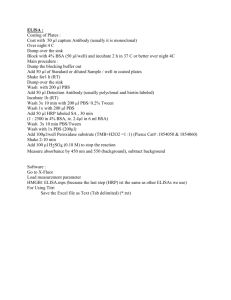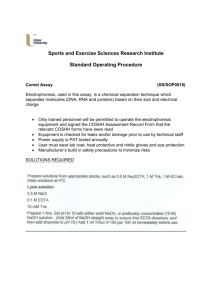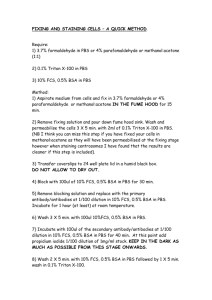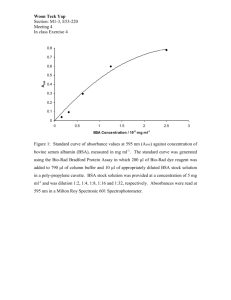Robertson Vibratome imunohisto
advertisement
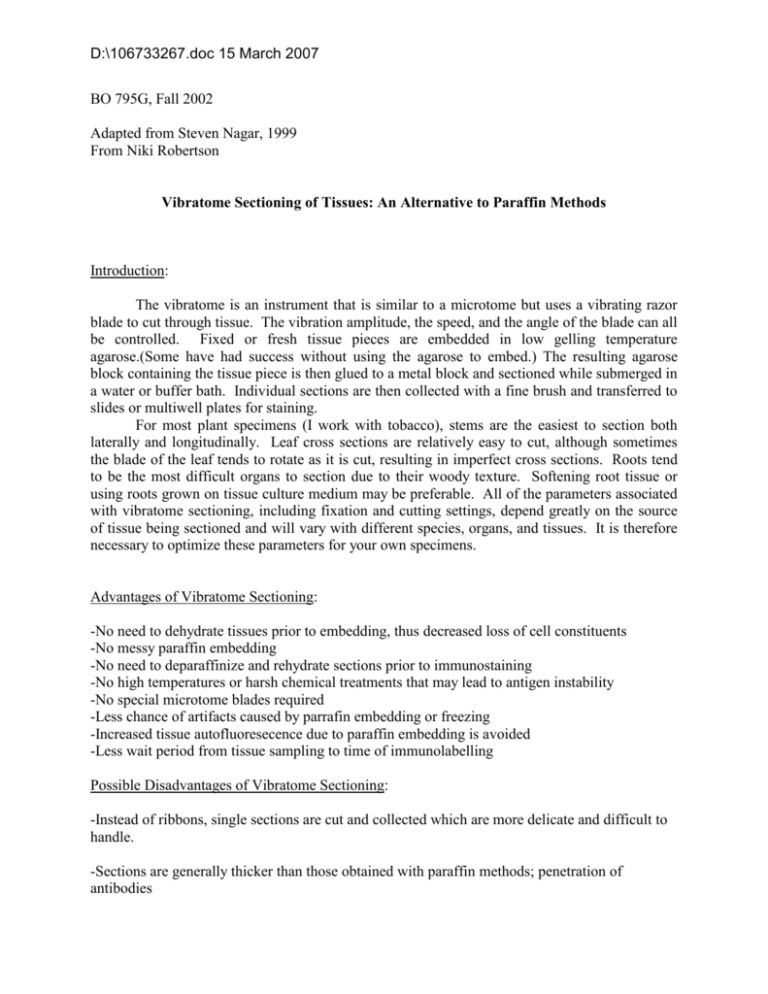
D:\106733267.doc 15 March 2007 BO 795G, Fall 2002 Adapted from Steven Nagar, 1999 From Niki Robertson Vibratome Sectioning of Tissues: An Alternative to Paraffin Methods Introduction: The vibratome is an instrument that is similar to a microtome but uses a vibrating razor blade to cut through tissue. The vibration amplitude, the speed, and the angle of the blade can all be controlled. Fixed or fresh tissue pieces are embedded in low gelling temperature agarose.(Some have had success without using the agarose to embed.) The resulting agarose block containing the tissue piece is then glued to a metal block and sectioned while submerged in a water or buffer bath. Individual sections are then collected with a fine brush and transferred to slides or multiwell plates for staining. For most plant specimens (I work with tobacco), stems are the easiest to section both laterally and longitudinally. Leaf cross sections are relatively easy to cut, although sometimes the blade of the leaf tends to rotate as it is cut, resulting in imperfect cross sections. Roots tend to be the most difficult organs to section due to their woody texture. Softening root tissue or using roots grown on tissue culture medium may be preferable. All of the parameters associated with vibratome sectioning, including fixation and cutting settings, depend greatly on the source of tissue being sectioned and will vary with different species, organs, and tissues. It is therefore necessary to optimize these parameters for your own specimens. Advantages of Vibratome Sectioning: -No need to dehydrate tissues prior to embedding, thus decreased loss of cell constituents -No messy paraffin embedding -No need to deparaffinize and rehydrate sections prior to immunostaining -No high temperatures or harsh chemical treatments that may lead to antigen instability -No special microtome blades required -Less chance of artifacts caused by parrafin embedding or freezing -Increased tissue autofluoresecence due to paraffin embedding is avoided -Less wait period from tissue sampling to time of immunolabelling Possible Disadvantages of Vibratome Sectioning: -Instead of ribbons, single sections are cut and collected which are more delicate and difficult to handle. -Sections are generally thicker than those obtained with paraffin methods; penetration of antibodies D:\106733267.doc 15 March 2007 and other reagents may be slower and thus longer incubation times may be necessary. Also, thick sections may be difficult to image with the microscope. (However, thick sections are compatible and sometimes even desirable if using confocal microscopy.) -Securing vibratome sections to glass slides can be difficult or impossible, due to the thickness of the sections. p.2 Preparation of Tissues for Vibratome Sectioning and Immunolabeling of Microtubules Fixation: Fixation conditions vary depending on tissue type and the target antigen so it is best to consult the literature to obtain some starting ideas for your system. The protocol below has been used to label microtubules in tobacco leaf and stem tissues. Protocol Fixative for Plant Microtubules: 50 mM PIPES 5 mM MgSO4 5 mM EGTA 0.1% Triton X-100 (optional) 1.0% DMSO (optional) 4.0% formaldehyde (I use ampules of 16% formaldehyde from EMS) pH 6.9 Tissue pieces should be about 0.5cm x 0.5 or 1.0cm in size if possible (the smaller the better, as long as they are not too small to handle). I routinely fix tobacco tissues 4h to overnight at room temperature. This varies with each species, organ and tissue type, localization target, etc. For in situ hybridizations, a shorter fixation time (2-4 hrs.) is generally recommended as overfixation will impede the penetration of nucleic acid probes. Tissues are then washed with several changes of the same buffer as above, without the formaldehyde. For antibody work, this is less of a problem. Vibratome Sectioning: D:\106733267.doc 15 March 2007 After fixation, the tissue pieces are washed briefly in 50mM PIPES buffer (3 changes over a period of 30 minutes). Tissues are then embedded in 5.0% low gelling temperature agarose (Sigma Type XI, A-3038) and allowed to cool until solid. I use small 5ml plastic disposable microbeakers as molds. Several tissue pieces can be embedded in each mold. It is important to have the tissue surrounded by agarose on all sides when it is finally solidified. A small block of agarose containing a tissue piece is cut out and trimmed in such a way as to yield proper final orientation of the tissue when placed on the metal block holder. After the fine trimming is completed, the agarose block is glued onto a metal block holder with super glue, allowed to dry for about 5 min, and then sectioned on the vibratome. See vibratome demonstration for more details on vibratome sectioning. Fluorescent Immunolocalization of Plant Microtubules Note: buffer used here, PBS/BSA is 1X PBS, pH7.4 + 0.1% BSA + 0.01% Na azide For 1 liter of 1X PBS/BSA: 8.0g NaCl 0.2g KCl 1.44g Na2HPO4 0.24g KH2PO4 1.0g BSA 0.1g NaN3 pH 7.4 Cut vibratome sections 50-60 um (or thinner if you can retain good morphology), collect them with a fine bristle paintbrush, and place into PBS/BSA in multiwell plates. 1. Block sections in 10% goat serum in PBS/BSA for 1h at room temp on Nutator or orbital shaker. 2. Rinse 3x 5 min. in PBS/BSA at room temperature. 3. Incubate in Amersham's (N 357) monoclonal anti--tubulin at 1:100 overnight at 4˚C. D:\106733267.doc 15 March 2007 4. Rinse 3x 10 min. in PBS/BSA at room temperature. 5. Incubate in BODIPY-FL Goat anti-mouse secondary antibody (Molecular Probes) at a final concentration of 10ug/ml (1:200 for most batches, but check label) in PBS/BSA for 1h at room temperature, covered with foil. 6. Rinse 3x10 min. in PBS/BSA at room temperature. 7. Mount on slides in 1XPBS: Glycerol (1:9), containing 0.2ug/ml DAPI 8. View under FITC/UV excitation. D:\106733267.doc 15 March 2007
